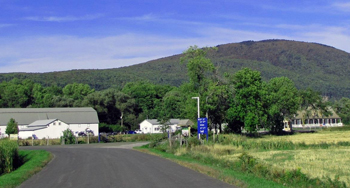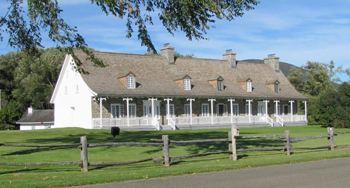La Petite-Ferme du cap Tourmente National Historic Site

La Petite-Ferme is located in a landscape of remarkable beauty, where the St. Lawrence River meets the great coastal marsh and the tidal plain. It was because of these unique conditions that the site was recognized early on as being particularly favourable for human settlement. With an Indigenous presence in the area dating back more than 2,000 years, la Petite Ferme is part of the vast network of known paleohistoric sites of the Cap Tourmente plains. It was at this strategic location that Samuel de Champlain had a farm built in 1626 to raise livestock, before it became a source of food for the small community of the newly formed Québec City. The remnants found on the site or still buried there are among the rare tangible traces of Champlain’s work in the St. Lawrence Valley. La Petite-Ferme was purchased by Monseigneur François de Montmorency Laval in 1664, and it bears witness to the unique evolution of the Séminaire de Québec, which operated the farm for 300 consecutive years and contributed to the farm’s conservation through its continuous presence. United by their history, functions, architecture, and their relationship with the surrounding landscape, the group of farm buildings reflect close to 400 years of agricultural use, making this a highly symbolic place.

Champlain called the site “Cap de Tourmente” (“cape of storms”) because the waters of the river rise at the slightest gust of wind. The farm built by Champlain was used as a food reserve for the first settlers to arrive at the Habitation de Québec. It became the first livestock farm in the St. Lawrence Valley and one of the first farms in New France.
La Petite-Ferme was at the heart of the Séminaire de Québec, contributing to its educational work and, through revenues arising from its operations, ensuring that the Séminaire could carry out its work for over 300 years. In 1664, Monseigneur de Laval purchased almost all the land on Côte de Beaupré in order to guarantee the establishment and existence of his Séminaire de Québec. He likely began building the house in that year, though its existence is only confirmed three years later. In the 18th century, La Petite-Ferme became one of the largest farms in New France. In 1759, its activities were disrupted by the threat of a British invasion when eight English ships dropped anchor at the entrance to the crossing known as “la traverse” at Cap Tourmente. La Petite-Ferme was completely burned down, except for the dwelling house, which resisted the fire and destruction. The Séminaire continued to operate its farms up until the 20th century. Beginning in the 1920s, agriculture in Quebec began to decline due to industrialization, urban development, and the advancement of farming technologies. During the second half of the 20th century, the Séminaire began to sell some of its lands, and beginning in 1969, the Government of Canada began to acquire various farms, including La Petite-Ferme, and established the Cap Tourmente National Wildlife Area.

The house is the only preserved building dating from the French Regime in Cap Tourmente, and is also the oldest evidence of the presence of the Séminaire de Québec. It is a handsome example of a French Regime residence, with picturesque features added in the 19th century showing neo-classical influence. The site includes remains from the Champlain’s farm and from buildings built in the early 20th century: the washhouse/blacksmith’s shop, the barn/cowshed, and the grain shed, as well as a workshop/bathroom built in 1964.
The National Program of Historical Commemoration relies on the participation of Canadians in the identification of places, events and persons of national historic significance. Any member of the public can nominate a topic for consideration by the Historic Sites and Monuments Board of Canada.
- Date modified :